Article Critique: Analyzing Motivation, Effectiveness, and Efficiency
VerifiedAdded on 2020/03/23
|8
|2020
|311
Report
AI Summary
This report provides a critical analysis of an article examining the relationship between employee motivation and organizational efficiency. The report begins by introducing the concept of motivation and its significance in achieving organizational objectives, emphasizing the need to meet employee needs to drive desired behaviors. The strengths of the article include providing background information on motivation and efficiency, discussing factors affecting efficiency, and analyzing the relationship between motivation and effectiveness. However, the report also identifies weaknesses, such as the lack of a clear theoretical framework and the potential for biased responses due to the context of the study. The analysis further highlights the direct correlation between employee motivation and organizational effectiveness, with motivated employees demonstrating improved performance. The report emphasizes the role of management in implementing effective motivation strategies, which include employee involvement in decision-making and equitable treatment. The conclusion underscores the importance of employee motivation in enhancing productivity and achieving better business outcomes, regardless of demographic characteristics. The report references several scholarly articles to support its claims and provide a comprehensive understanding of the topic.
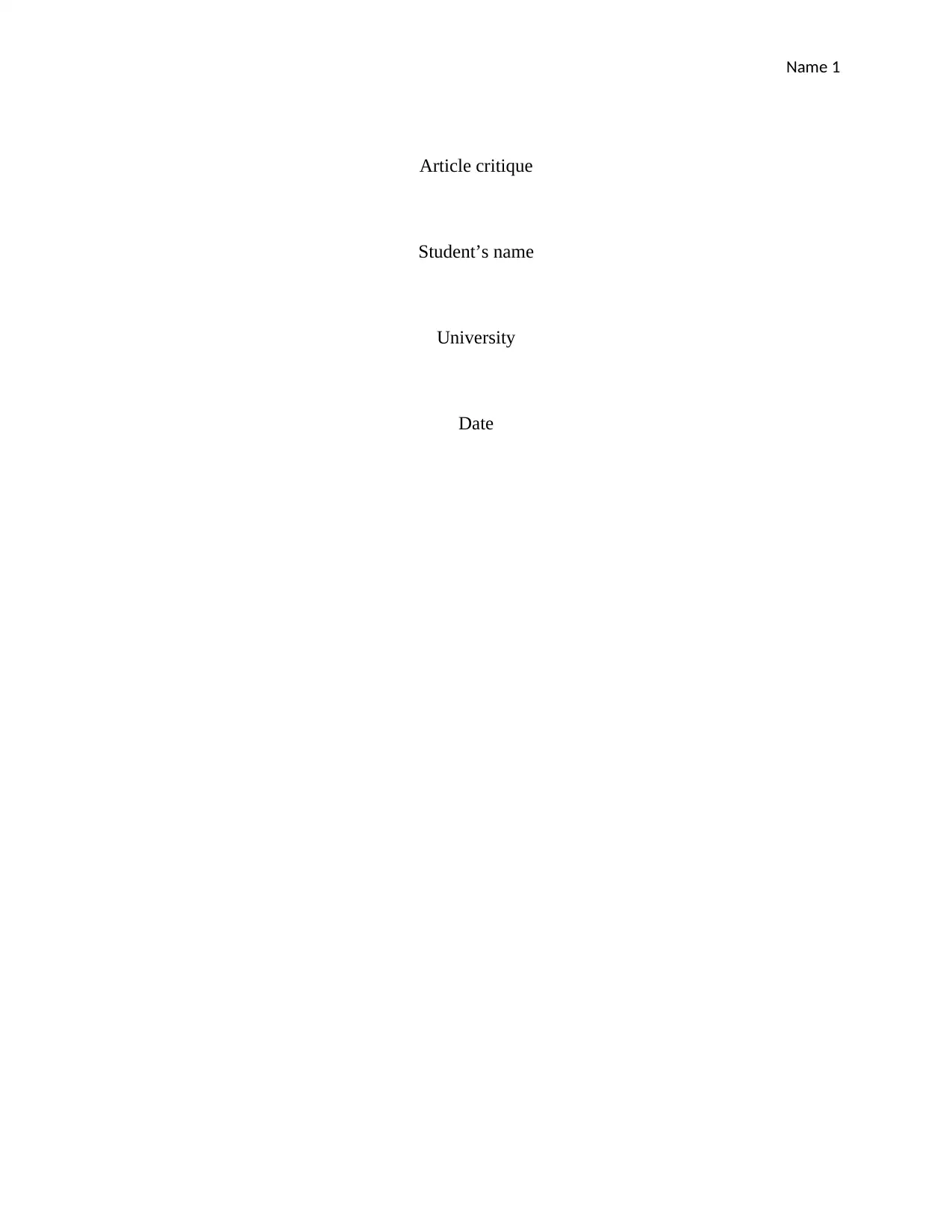
Name 1
Article critique
Student’s name
University
Date
Article critique
Student’s name
University
Date
Paraphrase This Document
Need a fresh take? Get an instant paraphrase of this document with our AI Paraphraser
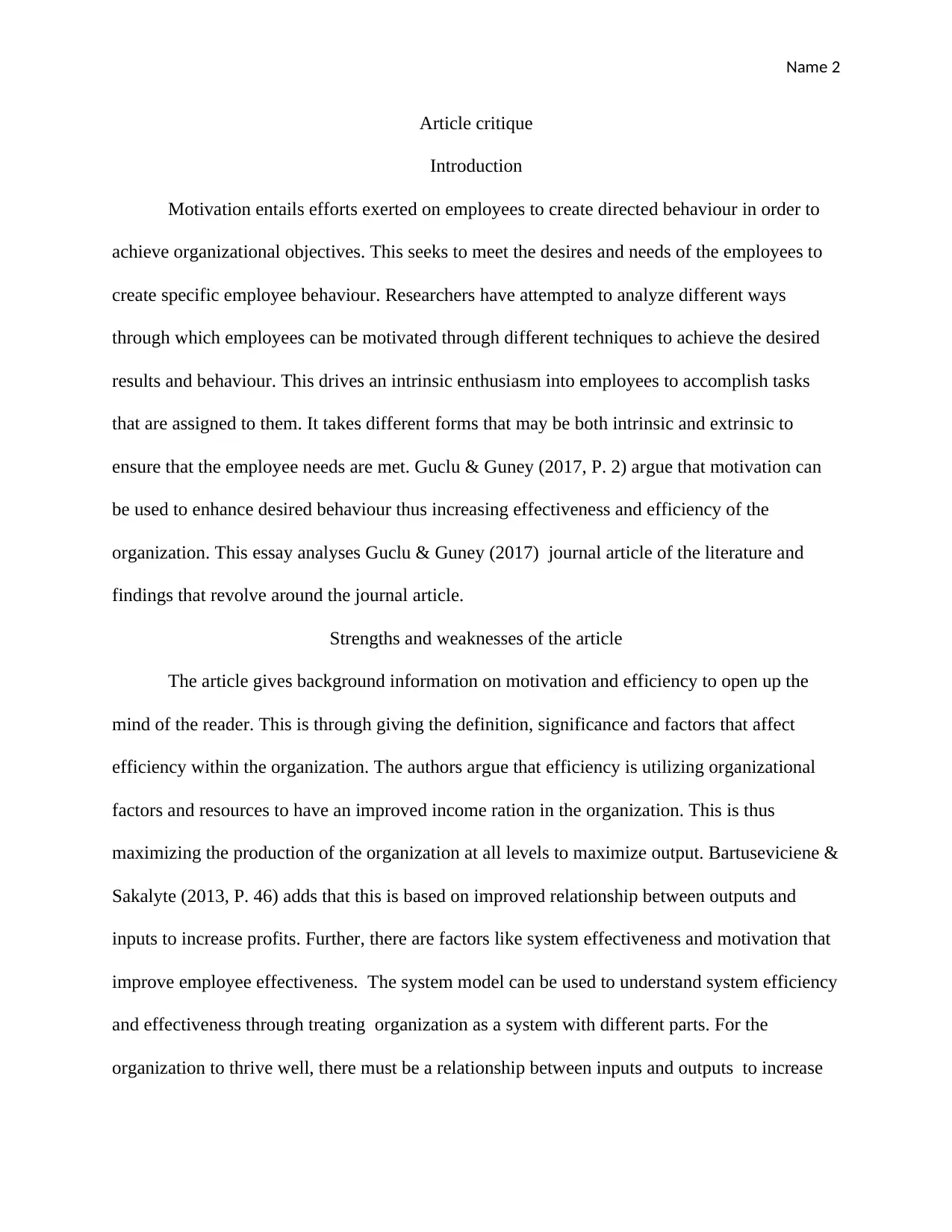
Name 2
Article critique
Introduction
Motivation entails efforts exerted on employees to create directed behaviour in order to
achieve organizational objectives. This seeks to meet the desires and needs of the employees to
create specific employee behaviour. Researchers have attempted to analyze different ways
through which employees can be motivated through different techniques to achieve the desired
results and behaviour. This drives an intrinsic enthusiasm into employees to accomplish tasks
that are assigned to them. It takes different forms that may be both intrinsic and extrinsic to
ensure that the employee needs are met. Guclu & Guney (2017, P. 2) argue that motivation can
be used to enhance desired behaviour thus increasing effectiveness and efficiency of the
organization. This essay analyses Guclu & Guney (2017) journal article of the literature and
findings that revolve around the journal article.
Strengths and weaknesses of the article
The article gives background information on motivation and efficiency to open up the
mind of the reader. This is through giving the definition, significance and factors that affect
efficiency within the organization. The authors argue that efficiency is utilizing organizational
factors and resources to have an improved income ration in the organization. This is thus
maximizing the production of the organization at all levels to maximize output. Bartuseviciene &
Sakalyte (2013, P. 46) adds that this is based on improved relationship between outputs and
inputs to increase profits. Further, there are factors like system effectiveness and motivation that
improve employee effectiveness. The system model can be used to understand system efficiency
and effectiveness through treating organization as a system with different parts. For the
organization to thrive well, there must be a relationship between inputs and outputs to increase
Article critique
Introduction
Motivation entails efforts exerted on employees to create directed behaviour in order to
achieve organizational objectives. This seeks to meet the desires and needs of the employees to
create specific employee behaviour. Researchers have attempted to analyze different ways
through which employees can be motivated through different techniques to achieve the desired
results and behaviour. This drives an intrinsic enthusiasm into employees to accomplish tasks
that are assigned to them. It takes different forms that may be both intrinsic and extrinsic to
ensure that the employee needs are met. Guclu & Guney (2017, P. 2) argue that motivation can
be used to enhance desired behaviour thus increasing effectiveness and efficiency of the
organization. This essay analyses Guclu & Guney (2017) journal article of the literature and
findings that revolve around the journal article.
Strengths and weaknesses of the article
The article gives background information on motivation and efficiency to open up the
mind of the reader. This is through giving the definition, significance and factors that affect
efficiency within the organization. The authors argue that efficiency is utilizing organizational
factors and resources to have an improved income ration in the organization. This is thus
maximizing the production of the organization at all levels to maximize output. Bartuseviciene &
Sakalyte (2013, P. 46) adds that this is based on improved relationship between outputs and
inputs to increase profits. Further, there are factors like system effectiveness and motivation that
improve employee effectiveness. The system model can be used to understand system efficiency
and effectiveness through treating organization as a system with different parts. For the
organization to thrive well, there must be a relationship between inputs and outputs to increase
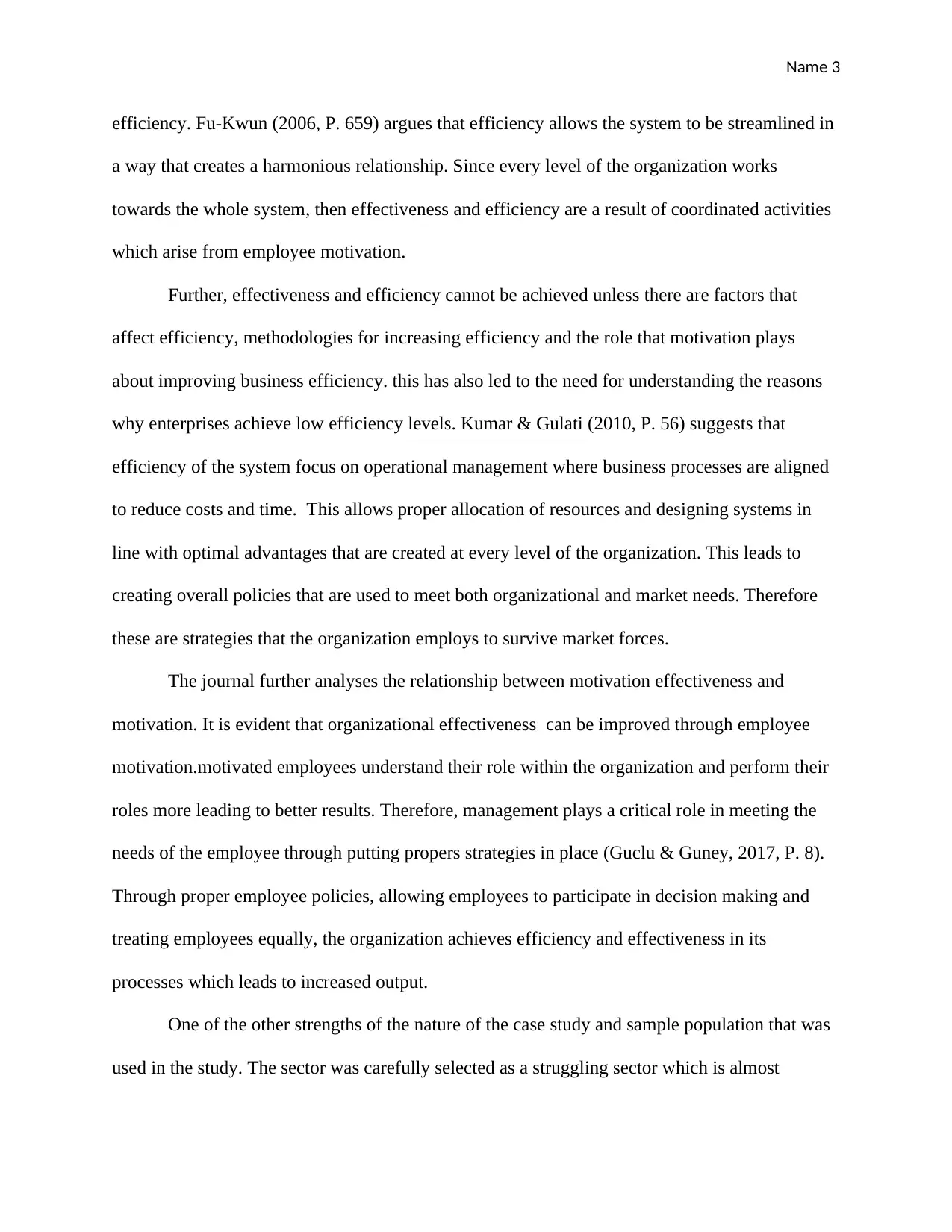
Name 3
efficiency. Fu-Kwun (2006, P. 659) argues that efficiency allows the system to be streamlined in
a way that creates a harmonious relationship. Since every level of the organization works
towards the whole system, then effectiveness and efficiency are a result of coordinated activities
which arise from employee motivation.
Further, effectiveness and efficiency cannot be achieved unless there are factors that
affect efficiency, methodologies for increasing efficiency and the role that motivation plays
about improving business efficiency. this has also led to the need for understanding the reasons
why enterprises achieve low efficiency levels. Kumar & Gulati (2010, P. 56) suggests that
efficiency of the system focus on operational management where business processes are aligned
to reduce costs and time. This allows proper allocation of resources and designing systems in
line with optimal advantages that are created at every level of the organization. This leads to
creating overall policies that are used to meet both organizational and market needs. Therefore
these are strategies that the organization employs to survive market forces.
The journal further analyses the relationship between motivation effectiveness and
motivation. It is evident that organizational effectiveness can be improved through employee
motivation.motivated employees understand their role within the organization and perform their
roles more leading to better results. Therefore, management plays a critical role in meeting the
needs of the employee through putting propers strategies in place (Guclu & Guney, 2017, P. 8).
Through proper employee policies, allowing employees to participate in decision making and
treating employees equally, the organization achieves efficiency and effectiveness in its
processes which leads to increased output.
One of the other strengths of the nature of the case study and sample population that was
used in the study. The sector was carefully selected as a struggling sector which is almost
efficiency. Fu-Kwun (2006, P. 659) argues that efficiency allows the system to be streamlined in
a way that creates a harmonious relationship. Since every level of the organization works
towards the whole system, then effectiveness and efficiency are a result of coordinated activities
which arise from employee motivation.
Further, effectiveness and efficiency cannot be achieved unless there are factors that
affect efficiency, methodologies for increasing efficiency and the role that motivation plays
about improving business efficiency. this has also led to the need for understanding the reasons
why enterprises achieve low efficiency levels. Kumar & Gulati (2010, P. 56) suggests that
efficiency of the system focus on operational management where business processes are aligned
to reduce costs and time. This allows proper allocation of resources and designing systems in
line with optimal advantages that are created at every level of the organization. This leads to
creating overall policies that are used to meet both organizational and market needs. Therefore
these are strategies that the organization employs to survive market forces.
The journal further analyses the relationship between motivation effectiveness and
motivation. It is evident that organizational effectiveness can be improved through employee
motivation.motivated employees understand their role within the organization and perform their
roles more leading to better results. Therefore, management plays a critical role in meeting the
needs of the employee through putting propers strategies in place (Guclu & Guney, 2017, P. 8).
Through proper employee policies, allowing employees to participate in decision making and
treating employees equally, the organization achieves efficiency and effectiveness in its
processes which leads to increased output.
One of the other strengths of the nature of the case study and sample population that was
used in the study. The sector was carefully selected as a struggling sector which is almost
⊘ This is a preview!⊘
Do you want full access?
Subscribe today to unlock all pages.

Trusted by 1+ million students worldwide
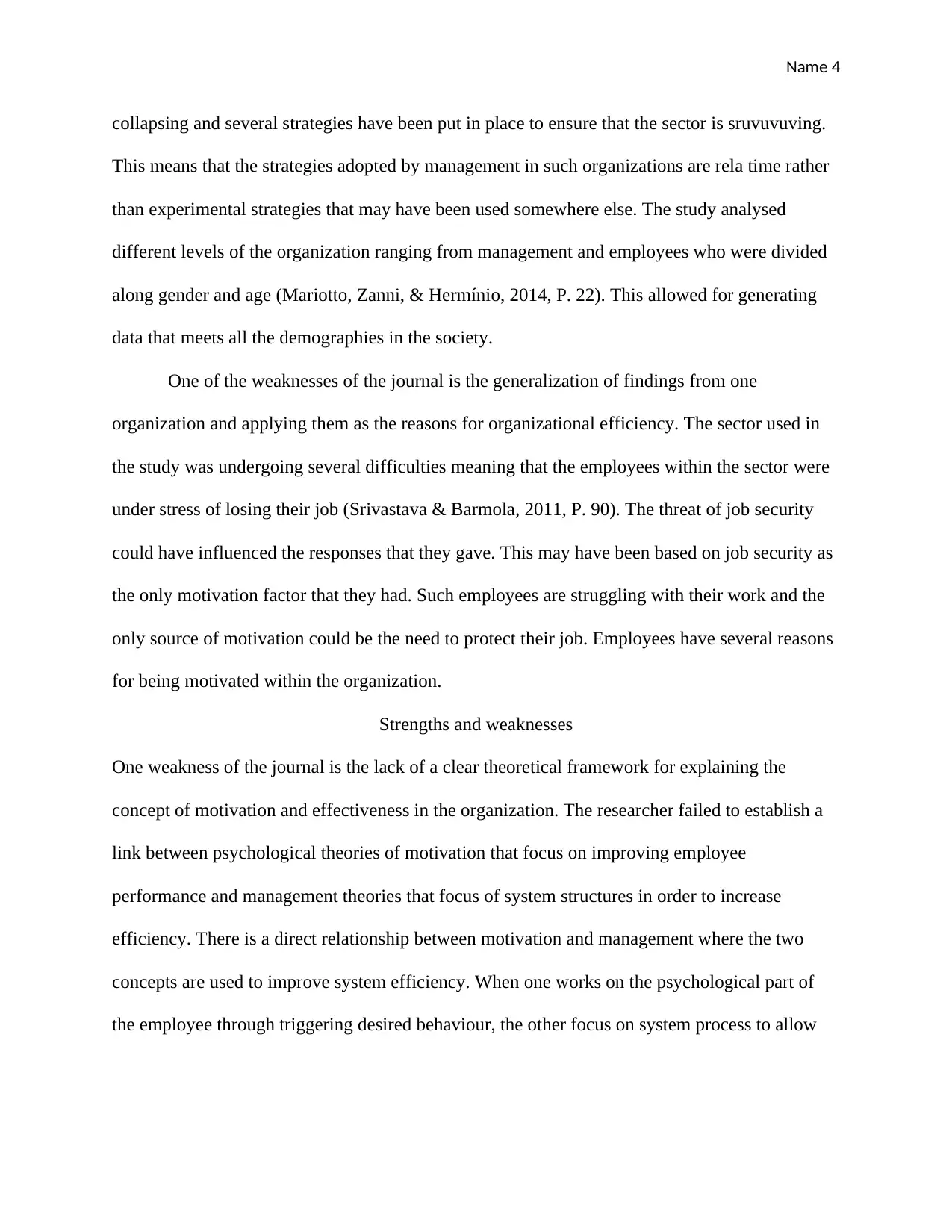
Name 4
collapsing and several strategies have been put in place to ensure that the sector is sruvuvuving.
This means that the strategies adopted by management in such organizations are rela time rather
than experimental strategies that may have been used somewhere else. The study analysed
different levels of the organization ranging from management and employees who were divided
along gender and age (Mariotto, Zanni, & Hermínio, 2014, P. 22). This allowed for generating
data that meets all the demographies in the society.
One of the weaknesses of the journal is the generalization of findings from one
organization and applying them as the reasons for organizational efficiency. The sector used in
the study was undergoing several difficulties meaning that the employees within the sector were
under stress of losing their job (Srivastava & Barmola, 2011, P. 90). The threat of job security
could have influenced the responses that they gave. This may have been based on job security as
the only motivation factor that they had. Such employees are struggling with their work and the
only source of motivation could be the need to protect their job. Employees have several reasons
for being motivated within the organization.
Strengths and weaknesses
One weakness of the journal is the lack of a clear theoretical framework for explaining the
concept of motivation and effectiveness in the organization. The researcher failed to establish a
link between psychological theories of motivation that focus on improving employee
performance and management theories that focus of system structures in order to increase
efficiency. There is a direct relationship between motivation and management where the two
concepts are used to improve system efficiency. When one works on the psychological part of
the employee through triggering desired behaviour, the other focus on system process to allow
collapsing and several strategies have been put in place to ensure that the sector is sruvuvuving.
This means that the strategies adopted by management in such organizations are rela time rather
than experimental strategies that may have been used somewhere else. The study analysed
different levels of the organization ranging from management and employees who were divided
along gender and age (Mariotto, Zanni, & Hermínio, 2014, P. 22). This allowed for generating
data that meets all the demographies in the society.
One of the weaknesses of the journal is the generalization of findings from one
organization and applying them as the reasons for organizational efficiency. The sector used in
the study was undergoing several difficulties meaning that the employees within the sector were
under stress of losing their job (Srivastava & Barmola, 2011, P. 90). The threat of job security
could have influenced the responses that they gave. This may have been based on job security as
the only motivation factor that they had. Such employees are struggling with their work and the
only source of motivation could be the need to protect their job. Employees have several reasons
for being motivated within the organization.
Strengths and weaknesses
One weakness of the journal is the lack of a clear theoretical framework for explaining the
concept of motivation and effectiveness in the organization. The researcher failed to establish a
link between psychological theories of motivation that focus on improving employee
performance and management theories that focus of system structures in order to increase
efficiency. There is a direct relationship between motivation and management where the two
concepts are used to improve system efficiency. When one works on the psychological part of
the employee through triggering desired behaviour, the other focus on system process to allow
Paraphrase This Document
Need a fresh take? Get an instant paraphrase of this document with our AI Paraphraser
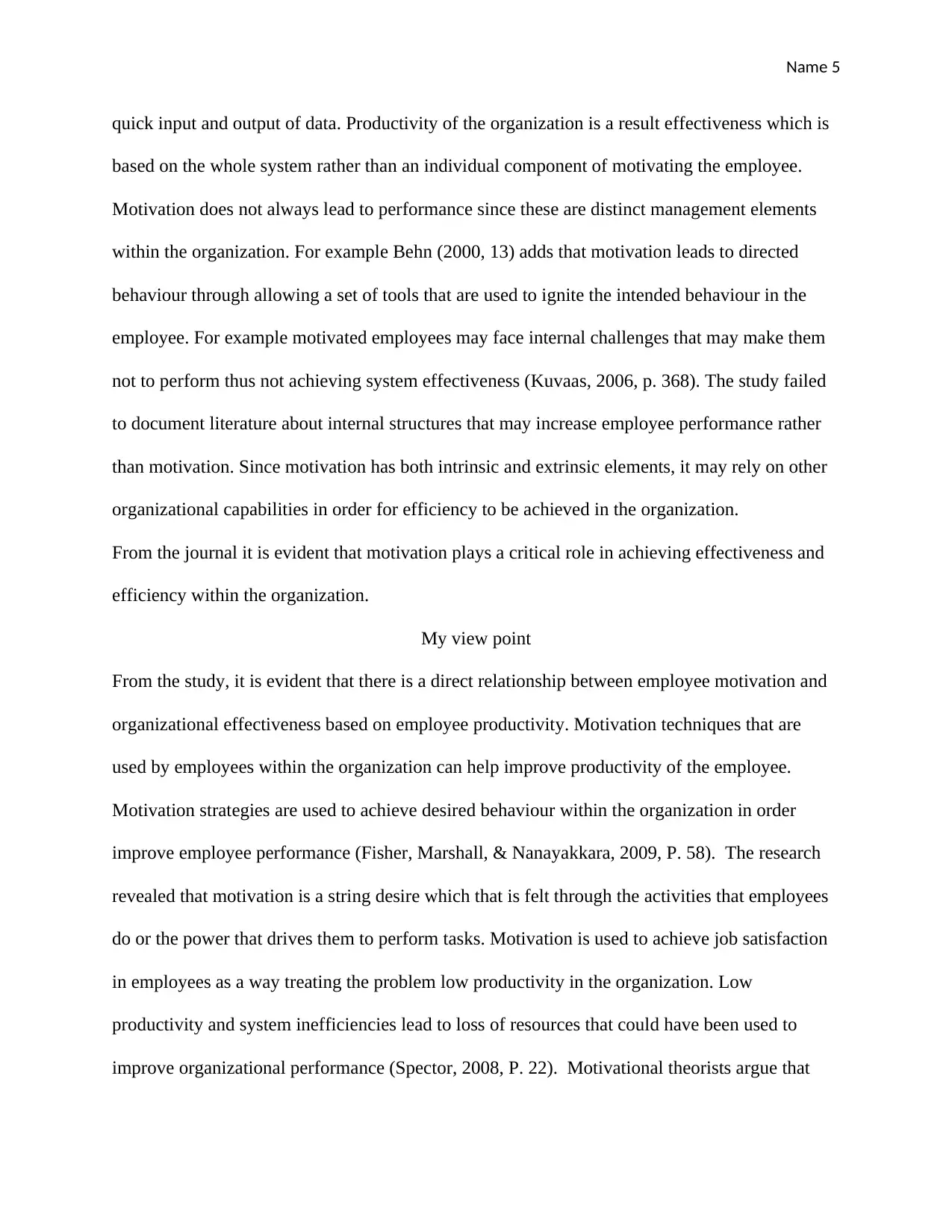
Name 5
quick input and output of data. Productivity of the organization is a result effectiveness which is
based on the whole system rather than an individual component of motivating the employee.
Motivation does not always lead to performance since these are distinct management elements
within the organization. For example Behn (2000, 13) adds that motivation leads to directed
behaviour through allowing a set of tools that are used to ignite the intended behaviour in the
employee. For example motivated employees may face internal challenges that may make them
not to perform thus not achieving system effectiveness (Kuvaas, 2006, p. 368). The study failed
to document literature about internal structures that may increase employee performance rather
than motivation. Since motivation has both intrinsic and extrinsic elements, it may rely on other
organizational capabilities in order for efficiency to be achieved in the organization.
From the journal it is evident that motivation plays a critical role in achieving effectiveness and
efficiency within the organization.
My view point
From the study, it is evident that there is a direct relationship between employee motivation and
organizational effectiveness based on employee productivity. Motivation techniques that are
used by employees within the organization can help improve productivity of the employee.
Motivation strategies are used to achieve desired behaviour within the organization in order
improve employee performance (Fisher, Marshall, & Nanayakkara, 2009, P. 58). The research
revealed that motivation is a string desire which that is felt through the activities that employees
do or the power that drives them to perform tasks. Motivation is used to achieve job satisfaction
in employees as a way treating the problem low productivity in the organization. Low
productivity and system inefficiencies lead to loss of resources that could have been used to
improve organizational performance (Spector, 2008, P. 22). Motivational theorists argue that
quick input and output of data. Productivity of the organization is a result effectiveness which is
based on the whole system rather than an individual component of motivating the employee.
Motivation does not always lead to performance since these are distinct management elements
within the organization. For example Behn (2000, 13) adds that motivation leads to directed
behaviour through allowing a set of tools that are used to ignite the intended behaviour in the
employee. For example motivated employees may face internal challenges that may make them
not to perform thus not achieving system effectiveness (Kuvaas, 2006, p. 368). The study failed
to document literature about internal structures that may increase employee performance rather
than motivation. Since motivation has both intrinsic and extrinsic elements, it may rely on other
organizational capabilities in order for efficiency to be achieved in the organization.
From the journal it is evident that motivation plays a critical role in achieving effectiveness and
efficiency within the organization.
My view point
From the study, it is evident that there is a direct relationship between employee motivation and
organizational effectiveness based on employee productivity. Motivation techniques that are
used by employees within the organization can help improve productivity of the employee.
Motivation strategies are used to achieve desired behaviour within the organization in order
improve employee performance (Fisher, Marshall, & Nanayakkara, 2009, P. 58). The research
revealed that motivation is a string desire which that is felt through the activities that employees
do or the power that drives them to perform tasks. Motivation is used to achieve job satisfaction
in employees as a way treating the problem low productivity in the organization. Low
productivity and system inefficiencies lead to loss of resources that could have been used to
improve organizational performance (Spector, 2008, P. 22). Motivational theorists argue that
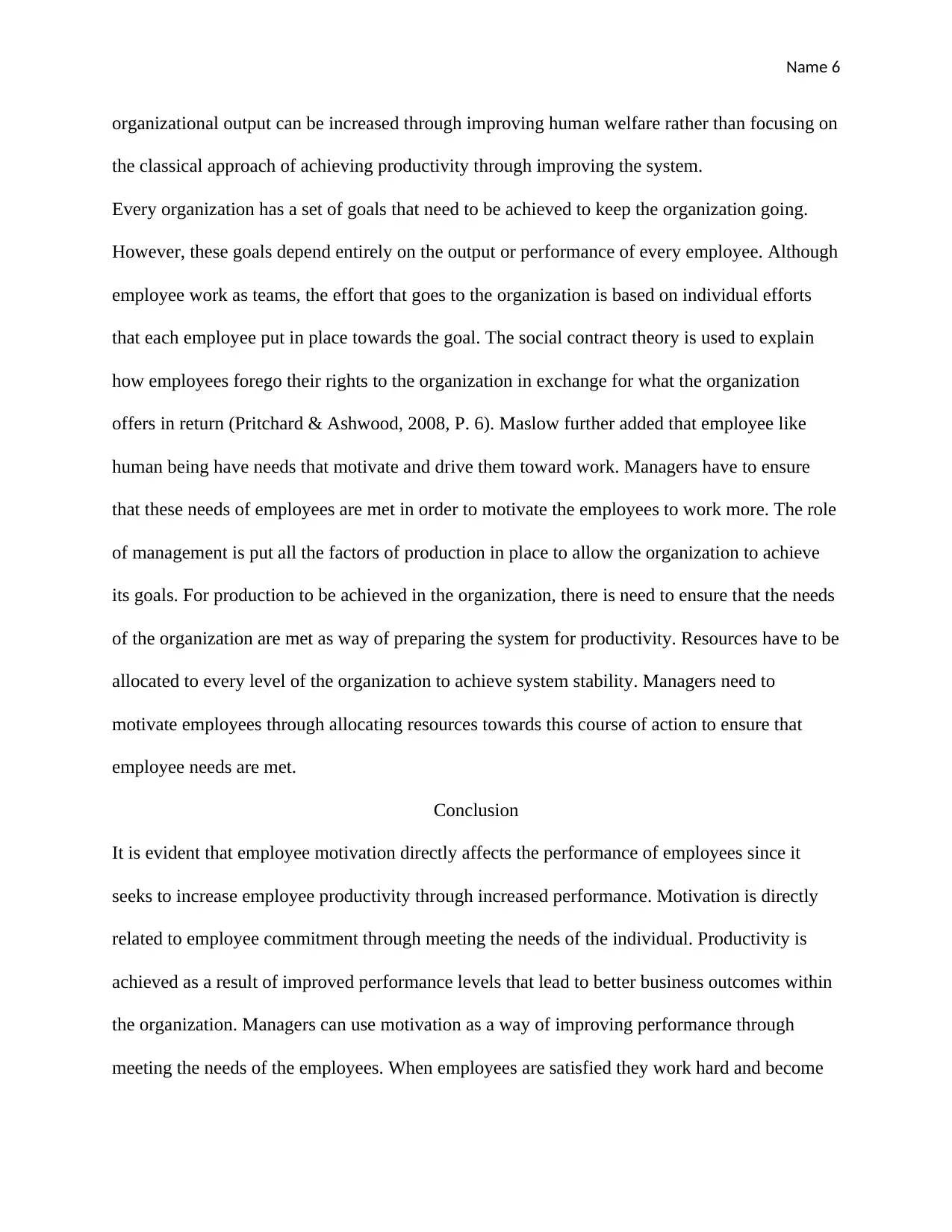
Name 6
organizational output can be increased through improving human welfare rather than focusing on
the classical approach of achieving productivity through improving the system.
Every organization has a set of goals that need to be achieved to keep the organization going.
However, these goals depend entirely on the output or performance of every employee. Although
employee work as teams, the effort that goes to the organization is based on individual efforts
that each employee put in place towards the goal. The social contract theory is used to explain
how employees forego their rights to the organization in exchange for what the organization
offers in return (Pritchard & Ashwood, 2008, P. 6). Maslow further added that employee like
human being have needs that motivate and drive them toward work. Managers have to ensure
that these needs of employees are met in order to motivate the employees to work more. The role
of management is put all the factors of production in place to allow the organization to achieve
its goals. For production to be achieved in the organization, there is need to ensure that the needs
of the organization are met as way of preparing the system for productivity. Resources have to be
allocated to every level of the organization to achieve system stability. Managers need to
motivate employees through allocating resources towards this course of action to ensure that
employee needs are met.
Conclusion
It is evident that employee motivation directly affects the performance of employees since it
seeks to increase employee productivity through increased performance. Motivation is directly
related to employee commitment through meeting the needs of the individual. Productivity is
achieved as a result of improved performance levels that lead to better business outcomes within
the organization. Managers can use motivation as a way of improving performance through
meeting the needs of the employees. When employees are satisfied they work hard and become
organizational output can be increased through improving human welfare rather than focusing on
the classical approach of achieving productivity through improving the system.
Every organization has a set of goals that need to be achieved to keep the organization going.
However, these goals depend entirely on the output or performance of every employee. Although
employee work as teams, the effort that goes to the organization is based on individual efforts
that each employee put in place towards the goal. The social contract theory is used to explain
how employees forego their rights to the organization in exchange for what the organization
offers in return (Pritchard & Ashwood, 2008, P. 6). Maslow further added that employee like
human being have needs that motivate and drive them toward work. Managers have to ensure
that these needs of employees are met in order to motivate the employees to work more. The role
of management is put all the factors of production in place to allow the organization to achieve
its goals. For production to be achieved in the organization, there is need to ensure that the needs
of the organization are met as way of preparing the system for productivity. Resources have to be
allocated to every level of the organization to achieve system stability. Managers need to
motivate employees through allocating resources towards this course of action to ensure that
employee needs are met.
Conclusion
It is evident that employee motivation directly affects the performance of employees since it
seeks to increase employee productivity through increased performance. Motivation is directly
related to employee commitment through meeting the needs of the individual. Productivity is
achieved as a result of improved performance levels that lead to better business outcomes within
the organization. Managers can use motivation as a way of improving performance through
meeting the needs of the employees. When employees are satisfied they work hard and become
⊘ This is a preview!⊘
Do you want full access?
Subscribe today to unlock all pages.

Trusted by 1+ million students worldwide
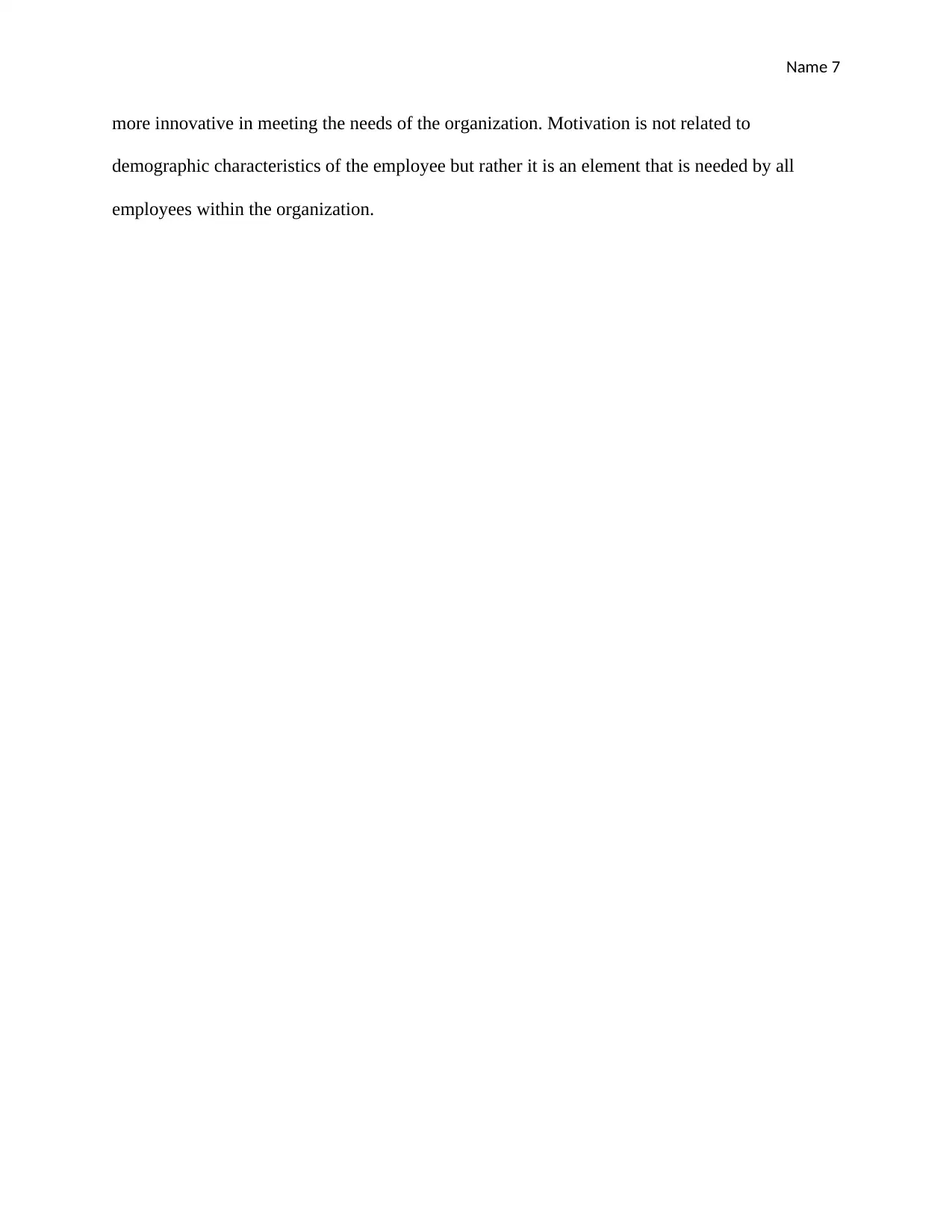
Name 7
more innovative in meeting the needs of the organization. Motivation is not related to
demographic characteristics of the employee but rather it is an element that is needed by all
employees within the organization.
more innovative in meeting the needs of the organization. Motivation is not related to
demographic characteristics of the employee but rather it is an element that is needed by all
employees within the organization.
Paraphrase This Document
Need a fresh take? Get an instant paraphrase of this document with our AI Paraphraser
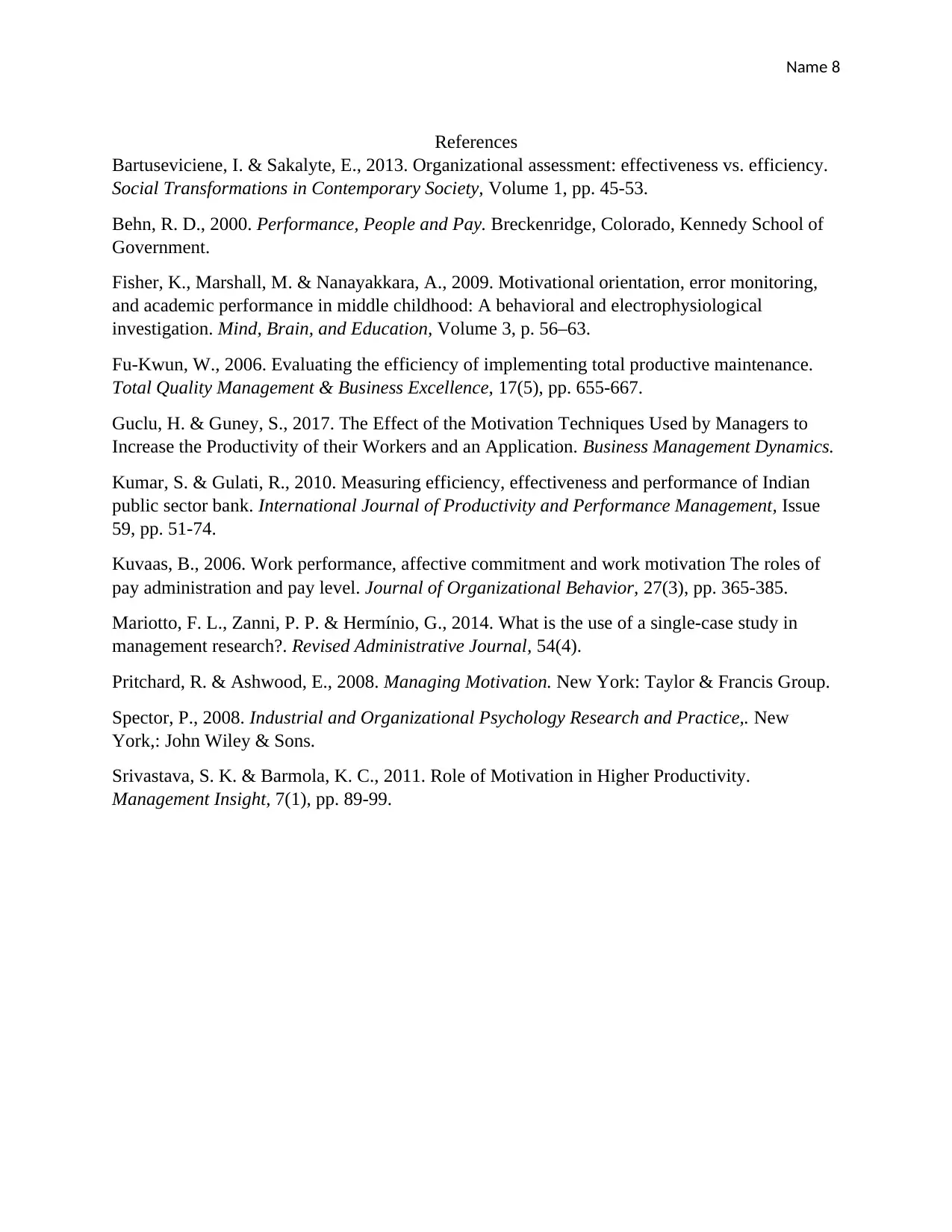
Name 8
References
Bartuseviciene, I. & Sakalyte, E., 2013. Organizational assessment: effectiveness vs. efficiency.
Social Transformations in Contemporary Society, Volume 1, pp. 45-53.
Behn, R. D., 2000. Performance, People and Pay. Breckenridge, Colorado, Kennedy School of
Government.
Fisher, K., Marshall, M. & Nanayakkara, A., 2009. Motivational orientation, error monitoring,
and academic performance in middle childhood: A behavioral and electrophysiological
investigation. Mind, Brain, and Education, Volume 3, p. 56–63.
Fu-Kwun, W., 2006. Evaluating the efficiency of implementing total productive maintenance.
Total Quality Management & Business Excellence, 17(5), pp. 655-667.
Guclu, H. & Guney, S., 2017. The Effect of the Motivation Techniques Used by Managers to
Increase the Productivity of their Workers and an Application. Business Management Dynamics.
Kumar, S. & Gulati, R., 2010. Measuring efficiency, effectiveness and performance of Indian
public sector bank. International Journal of Productivity and Performance Management, Issue
59, pp. 51-74.
Kuvaas, B., 2006. Work performance, affective commitment and work motivation The roles of
pay administration and pay level. Journal of Organizational Behavior, 27(3), pp. 365-385.
Mariotto, F. L., Zanni, P. P. & Hermínio, G., 2014. What is the use of a single-case study in
management research?. Revised Administrative Journal, 54(4).
Pritchard, R. & Ashwood, E., 2008. Managing Motivation. New York: Taylor & Francis Group.
Spector, P., 2008. Industrial and Organizational Psychology Research and Practice,. New
York,: John Wiley & Sons.
Srivastava, S. K. & Barmola, K. C., 2011. Role of Motivation in Higher Productivity.
Management Insight, 7(1), pp. 89-99.
References
Bartuseviciene, I. & Sakalyte, E., 2013. Organizational assessment: effectiveness vs. efficiency.
Social Transformations in Contemporary Society, Volume 1, pp. 45-53.
Behn, R. D., 2000. Performance, People and Pay. Breckenridge, Colorado, Kennedy School of
Government.
Fisher, K., Marshall, M. & Nanayakkara, A., 2009. Motivational orientation, error monitoring,
and academic performance in middle childhood: A behavioral and electrophysiological
investigation. Mind, Brain, and Education, Volume 3, p. 56–63.
Fu-Kwun, W., 2006. Evaluating the efficiency of implementing total productive maintenance.
Total Quality Management & Business Excellence, 17(5), pp. 655-667.
Guclu, H. & Guney, S., 2017. The Effect of the Motivation Techniques Used by Managers to
Increase the Productivity of their Workers and an Application. Business Management Dynamics.
Kumar, S. & Gulati, R., 2010. Measuring efficiency, effectiveness and performance of Indian
public sector bank. International Journal of Productivity and Performance Management, Issue
59, pp. 51-74.
Kuvaas, B., 2006. Work performance, affective commitment and work motivation The roles of
pay administration and pay level. Journal of Organizational Behavior, 27(3), pp. 365-385.
Mariotto, F. L., Zanni, P. P. & Hermínio, G., 2014. What is the use of a single-case study in
management research?. Revised Administrative Journal, 54(4).
Pritchard, R. & Ashwood, E., 2008. Managing Motivation. New York: Taylor & Francis Group.
Spector, P., 2008. Industrial and Organizational Psychology Research and Practice,. New
York,: John Wiley & Sons.
Srivastava, S. K. & Barmola, K. C., 2011. Role of Motivation in Higher Productivity.
Management Insight, 7(1), pp. 89-99.
1 out of 8
Related Documents
Your All-in-One AI-Powered Toolkit for Academic Success.
+13062052269
info@desklib.com
Available 24*7 on WhatsApp / Email
![[object Object]](/_next/static/media/star-bottom.7253800d.svg)
Unlock your academic potential
Copyright © 2020–2025 A2Z Services. All Rights Reserved. Developed and managed by ZUCOL.





